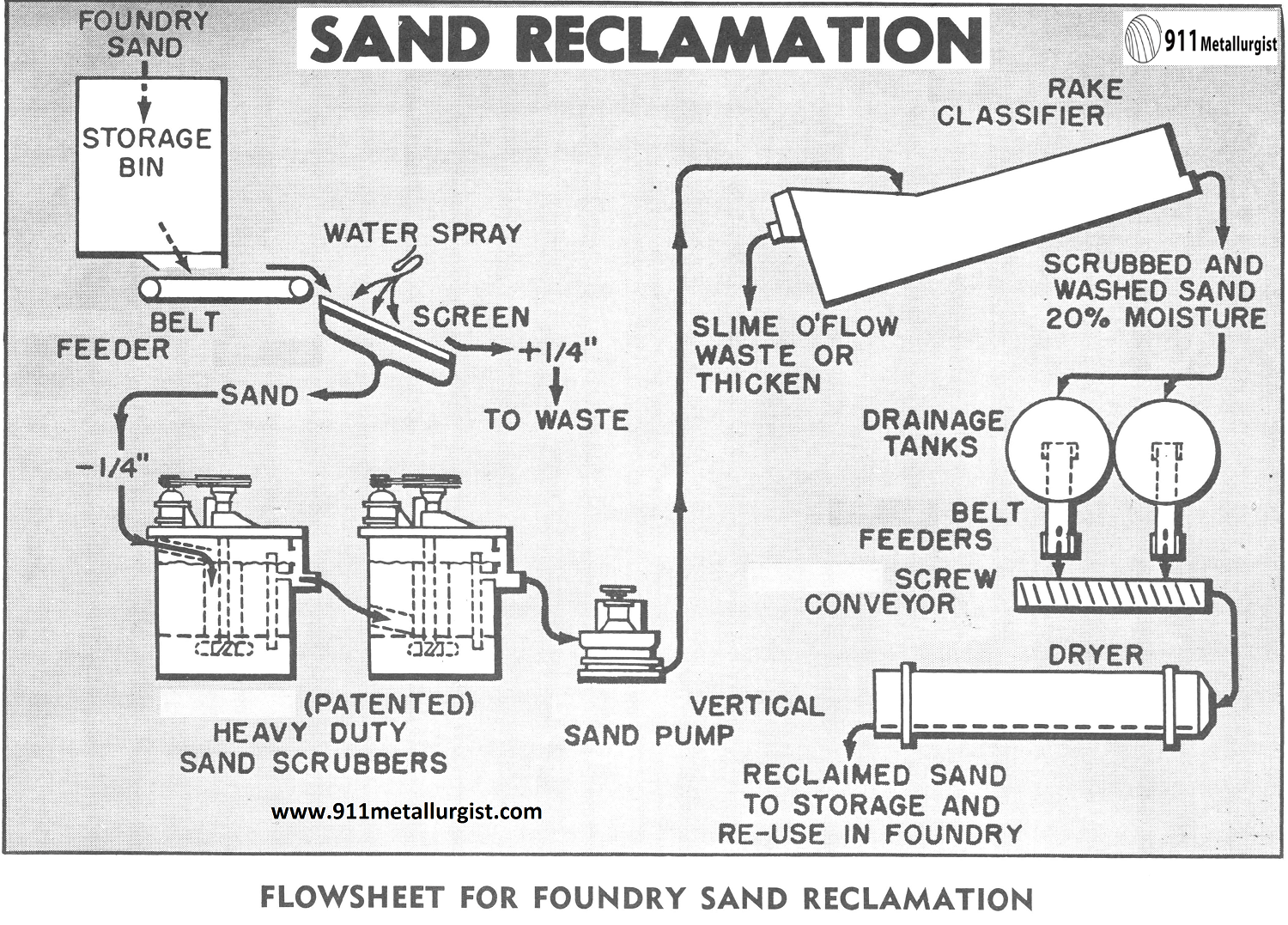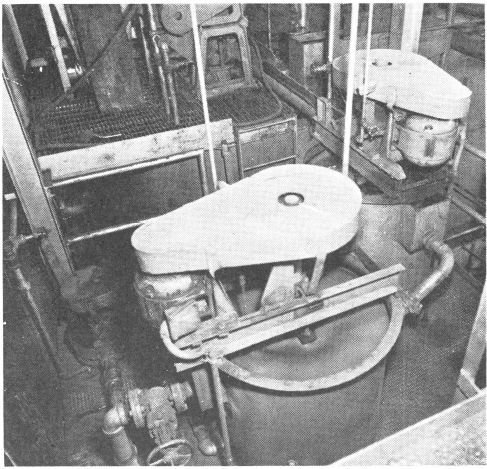The flowsheet shown in this study is particularly adapted to the requirements of the average foundry to reclaim foundry sand for re-use. Any foundry whose new sand delivered costs is too high should seriously consider reclamation with the flowsheet as illustrated. This reclaimed sand is usually equal to, or better than the original sand. Foundry sand once used must be thoroughly water scrubbed and water washed to remove objectional bonding materials, clay slimes, and fines. Such treatment will greatly extend the life of the sand and will cut to a minimum the requirements for new sand. Foundry castings made from molds using this reclaimed sand, can also be maintained up to the high standards as required.
In this flowsheet the Heavy Duty Sand Scrubber plays an extremely important role in removing the bonding and slime from the surface of the sand grains. This is done by attrition of sand grains striking one another at high velocity in a water and sand mixture, usually 40-50% solids. Data obtained from actual foundry sand reclamation installations has established this method of sand reclamation as far superior to existing methods including mulling, ignition, and dry separation. Test work at the Equipment Company Ore Testing Laboratory was performed in a Laboratory (Patented) Super-Agitator and Conditioner and commercial units have been modified to provide the extra power required for efficient scrubbing at high density, without choking or stoppage.

THE FLOWSHEET
Foundry molding sand to be reclaimed is stored in a suitable bin preferably of steel and of a size to hold sufficient tonnage for at least a one shift operation. The sand is metered or fed at a constant rate into the reclaiming system by a Adjustable Stroke Belt Feeder. Wet sand may be stored in a suitable sump tank and metered to the circuit by means of a Duplex Adjustable Stroke Diaphragm Pump.
Tramp oversize is removed from the sand as it passes over a stationary vibrating Screen (Dillon). The vibrating action of the Dillon Screen serves to break up lumps and usually a spray of water is added at this point to assist in pulping up the sand before it is introduced into the sand scrubbers.
The screened sand is fed down the standpipe of the first Heavy Duty Sand Scrubber and dropped directly on top of the down cast modified ship type propeller. Sufficient water is added to maintain a pulp density of 40 to 50% solids. This density plus the violent action of the propeller with controlled recirculation through the standpipe, loosens the bonding material and clay from the surface of the sand grains by attrition. To insure complete scrubbing, two of the Scrubbers are always operated in series thus reducing short circuiting to a minimum.
 At an eastern steel foundry,feed to two 3’x 3′ Heavy Duty Sand Scrubbers is metered from a 7′ 8″ diameter x 16′ 1″ Bolted Steel Tank (used as a surge bin) by a 2″ Duplex Adjustable Stroke Diaphragm Pump which may be seen mounted on the tank in the center background. A 1″ Vertical Sand Pump on the floor at the left, pumps the scrubbed sand to classification.
At an eastern steel foundry,feed to two 3’x 3′ Heavy Duty Sand Scrubbers is metered from a 7′ 8″ diameter x 16′ 1″ Bolted Steel Tank (used as a surge bin) by a 2″ Duplex Adjustable Stroke Diaphragm Pump which may be seen mounted on the tank in the center background. A 1″ Vertical Sand Pump on the floor at the left, pumps the scrubbed sand to classification.
The Scrubbers are of sufficient size to allow approximately 30 minutes contact time. Sand relief arrangements are provided in the Scrubbers to maintain an even flow of coarse sand through the system and thereby prevent a possible overload on the motors. The Scrubber mechanisms are of extra heavy construction for this service and usually the propeller and part of the shaft are rubber covered for greater wear resistance. The design of the Scrubber, with the standpipe and wearing plate over the propeller, permits shutting down and starting up the units on full load. It is therefore not necessary to drain the system at the end of each run.
The thoroughly scrubbed sand discharged from the second Scrubber is transferred by a Vertical Sand Pump to a Classifier for desliming and dewatering. Usually water for proper desliming is added to the pump thus permitting thorough dilution and mixing ahead of the Classifier; a dilution of 20% solids is normally satisfactory at this point. For thorough washing and desliming the Rake Classifier is well suited. The sand bed is turned over several times by the action of the rakes conveying the washed sands up the incline of the Classifier. Slimes and excess water overflow the Classifier weir and are diverted to waste. In case water reclamation is desirable the slimes are thickened in a Thickener and the clear water re-used. The Thickener slimes are removed from the Thickener by a Adjustable Stroke Diaphragm Pump and discarded to waste as a thick slurry.
The clean, dewatered sands discharged from the Classifier, usually at about 20% moisture, after further drainage in suitable tanks, are dried in a Rotary Sand Dryer to about 2% moisture. The sand is now ready for re-use in the foundry.
For the average small foundry the following equipment list is suggested for treating 2 to 3 tons of sand per hour on a continuous basis.
The total price for the equipment with motors and drives exclusive of the drying equipment as listed is approximate. Units are available for handling smaller and larger tonnages. The minimum tonnage that can be handled efficiently and economically is about one ton per hour.
Reports from operating plants indicate that total operating costs for a plant similar to the one outlined above, will lie within a range of $8 to $20 for each ton of sand reclaimed. For the average small plant reclaiming 2 to 3 tons of sand per hour the cost should not exceed $15 per ton. With new foundry sand costing $40-$45 a ton, the saving for the average foundry over a period of time is well worth the investment for the reclamation system as outlined. Several plants are now in operation using this system very successfully.
Source: This article is a reproduction of an excerpt of “In the Public Domain” documents held in 911Metallurgy Corp’s private library.
